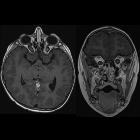Tumoren des Nervus opticus

Optic nerve
Hemangioblastoma with bilateral frontal lobe Oedema: a case report. Comparison of preoperative and postoperative MRI. The T1- and T2-weighted images show optic neuropathy before the operation. The T1 image shows isointensity (a), and the T2 and FLAIR images show hyperintensity (b, c). There was a significantly enhanced signal in the tumour after the enhancement scan (d). The FLAIR image shows hyperintensity of the left optic chiasma, visual radiation, and bilateral frontal lobe (e, f, g)

EYE AND
OCULAR ADNEXA: PILOCYTIC ASTROCYTOMA Magnetic resonance image of a large retrobulbar optic nerve tumor causing massive proptosis.

Preschooler
with seizures. Axial (left) and coronal T1 MRI with contrast of the orbits shows marked thickening of the optic nerves bilaterally.The diagnosis was bilateral optic pathway gliomas in a patient with neurofibromatosis type I.

Magnetic
resonance imaging of sellar and juxtasellar abnormalities in the paediatric population: an imaging review. Glioma in a 2-year-old girl with neurofibromatosis type 1. Sagittal (a) and axial (b) post contrast T1WI shows a partially enhancing lesion enlarging the optic chiasm and proximal optic nerves

Optic nerve
sheath meningioma: a case report. Axial MR image (T1 with fat saturation). An isointense to brain and optic nerve (arrow) lesion which produces exopthalmos. The lesion appears as marked widening along the path of the optic nerve but there is no intracranial extension.

Optic nerve
sheath meningioma: a case report. Axial MR image (T2 with fat saturation). The lesion is slightly hyperintense to the optic nerve (arrow).

Optic nerve
sheath meningioma: a case report. Axial MR image (T1 with fat saturation) after intravenous administration of paramagnetic media. There is homogeneous intense enhancement producing a "tram track" appearance around the hypointense optic nerve. Surrounding structures remain intact.
 Assoziationen und Differentialdiagnosen zu Tumoren des Nervus opticus:
Assoziationen und Differentialdiagnosen zu Tumoren des Nervus opticus:
